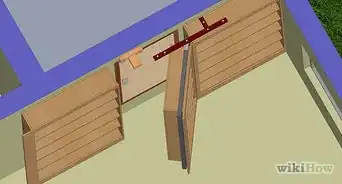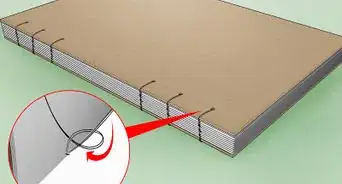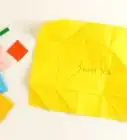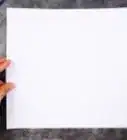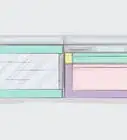wikiHow is a “wiki,” similar to Wikipedia, which means that many of our articles are co-written by multiple authors. To create this article, 112 people, some anonymous, worked to edit and improve it over time.
wikiHow marks an article as reader-approved once it receives enough positive feedback. This article received 14 testimonials and 91% of readers who voted found it helpful, earning it our reader-approved status.
This article has been viewed 1,797,686 times.
Learn more...
A hollow book can be a nifty way to hide something, whether it's a spare key, a secret note, or even money. Most people wouldn't think to browse your library for private or personal things. It's also a great way to pass something to someone discreetly--an unsuspecting onlooker will just think you're sharing a very good read!
Steps
-
1Select a book, preferably a thick one with a sturdy hardcover. (See 'tips' and 'warnings' first, about where to get an appropriate book and not to select a valuable/antique/currently popular/important book).
-
2Select the first few pages that you want to have free at the end of the project (plus one more) and hold them to the front cover with plastic food wrap so they do not get messed up with the glue. These pages, except for the last one, will not be cut out. This will allow the book to look like a book when it is opened up and will cover the hole itself.Advertisement
-
3Mix a solution of white glue and water. Make the consistency just enough for the glue to be runny, and more easily absorbed by the edge of the book's pages. 50% to 70% glue (30% to 50% water) or half a 35mm film canister full usually works well but use your judgment, given the thickness and size of the book. Alternatively, try a craft glue like Mod Podge.
-
4Now that you have the top cover and the first couple of pages wrapped in food wrap, brush the three edges of the book with the glue solution so that it is reasonably absorbed. This will hold the book's pages together. Remember: clean the brush off immediately, or else it will harden and become useless for step 9.
-
5Place something heavy on top of the book so as to apply pressure. Let the book dry for fifteen to thirty minutes.
-
6Open the book to reveal the first glued page. Draw a half-inch (1.2 cm) border within the edge, on all four sides (including the spine). Drill a hole in each corner of the newly drawn box to the depth you wish the hidden compartment to be. (This makes cutting out the pages easier because the blade does not have to make a 90-degree turn.) You may leave a few of the glued bottom pages uncut.
-
7Cut along the inside of the drawn line with a straight edge knife (a box cutter works especially well). Try to make the cut as vertical as possible, or else try to tilt it so the hole will narrow as you go down. Using a ruler, as shown in the image, can help a lot. Apply enough pressure to cut a few pages at a time or as many as you would like. A metal ruler is advisable.
-
8Continue cutting through the layers. Do not rush this step, because the slower and more carefully you do this, the smoother and straighter the inside edges will be. Remove the bits of paper from the inside that accumulate from the cutting.
-
9Brush the glue solution onto the inside edges of the hole and allow it to soak in. The glue dries clear, so don't be concerned if it drips a little. While waiting, apply a second coat of glue to the outside edges of the pages.
-
10Brush the "frame" of the hole with a light coat of glue. The saved page will be glued directly on top of the hole, essentially covering it (for now).
-
11Close the book again, this time without any spacers. Allow it to dry for about 15-30 minutes. In this drying phase, the saved page will become affixed to the hole, as mentioned in the previous step.
-
12Cut the saved page neatly along the edges of the hole so that the hole is visible and accessible once again. You may want to add a magnet of some kind before glueing this page in. The insides of the book may still be moist because the book had been closed while drying. Now is a good time to let the book dry while it's open.
-
13Check to make sure every part of the book is thoroughly dry. Touch it with your fingers, and when you are certain it is dry, fill it with your treasured items, shut the book, and put it on the bookshelf. Only you will know that this book has a secret compartment!
Community Q&A
-
QuestionWill the edges of the paper feel different, giving it away if someone touched it?
 Community AnswerThey might. Try to keep it in a place where people are unlikely to touch it, like on a bookshelf filled with other books.
Community AnswerThey might. Try to keep it in a place where people are unlikely to touch it, like on a bookshelf filled with other books. -
QuestionWhere can you buy cheap old hardcover books?
 Community AnswerGarage sales and used bookstores. Some libraries also have a bin of free books they're disposing of.
Community AnswerGarage sales and used bookstores. Some libraries also have a bin of free books they're disposing of. -
QuestionCan I use something other than a box cutter to cut the pages out?
 Community AnswerYes, but you'll need to be very careful with anything you choose. You could try scissors, but it would take a lot longer since you would have to cut the book in small sections. Make sure that anything you choose has a sharp blade.
Community AnswerYes, but you'll need to be very careful with anything you choose. You could try scissors, but it would take a lot longer since you would have to cut the book in small sections. Make sure that anything you choose has a sharp blade.
Warnings
- Although the Dremel tool cuts quickly, you may accidentally cut through the back of the book. Also be advised that it will burn the pages, and the smoke may smell bad, depending on the type of paper the book is made from. The depth of the cut is also limited to the radius of the cutting wheel. You will need to remove pages between cuts to go deeper.⧼thumbs_response⧽
- Hollow books are not effective against law enforcement.⧼thumbs_response⧽
- Burning paper often contains dioxins, which are a potent carcinogen: Make sure you ventilate the room, perhaps blowing a fan across the book as you work to keep the dangerous fumes from your face.⧼thumbs_response⧽
- When choosing a book, make sure it is not a book that you care about and that someone will want to read again. Also, make sure that it is not a book anyone else might ask to look at because it will be hard to come up with an excuse as to why you won't let them read it.⧼thumbs_response⧽
- Try adding a closing mechanism to keep your book closed like a magnet, belt buckle, or button. Otherwise, everything that you place inside will just fall out!⧼thumbs_response⧽
- Cutting an old book can contain many old, foreign, possibly harmful contaminants found within the dust. The dust particles can sit for many years, contain bacteria, and chemicals. Depending on your method of cutting, you may find a little to a maximum of dust in the air. It is recommended that you cut in a well-ventilated area, use of an air vacuum with a HEPA filter is preferable, and most importantly you use a dust mask that can filter out the breathing of such dust particles. Eyeglasses can also be used to prevent dust from getting into the eyes, and protect from particles (ie: small rock, tiny metal particles from an old rusty pipe) that can shoot out from underneath a blade into the eye. Especially if using motorized tools, such as a Dremel. Dust will fill the air, so close all doors, to minimize the spreading of such dust particles.⧼thumbs_response⧽
Things You'll Need
- Hardcover book
- White glue
- Tap water
- Container to hold glue solution
- Plastic food wrap
- X-acto knife, or box cutter.
- Brush to apply glue solution
- Rags to wipe up any spills
- Pencil or Pen
- Ruler
- Something Heavy to weigh things down with
- Flat work surface
- Drill with a small drill bit
References
- How To Do Stuff. Original source of this article. Shared with permission. View the site for many more ideas.
- audio73chThanks also to the originator of Hollow Book. The complete history of the tutorial is on his blog or at least the appearances he knows of.

